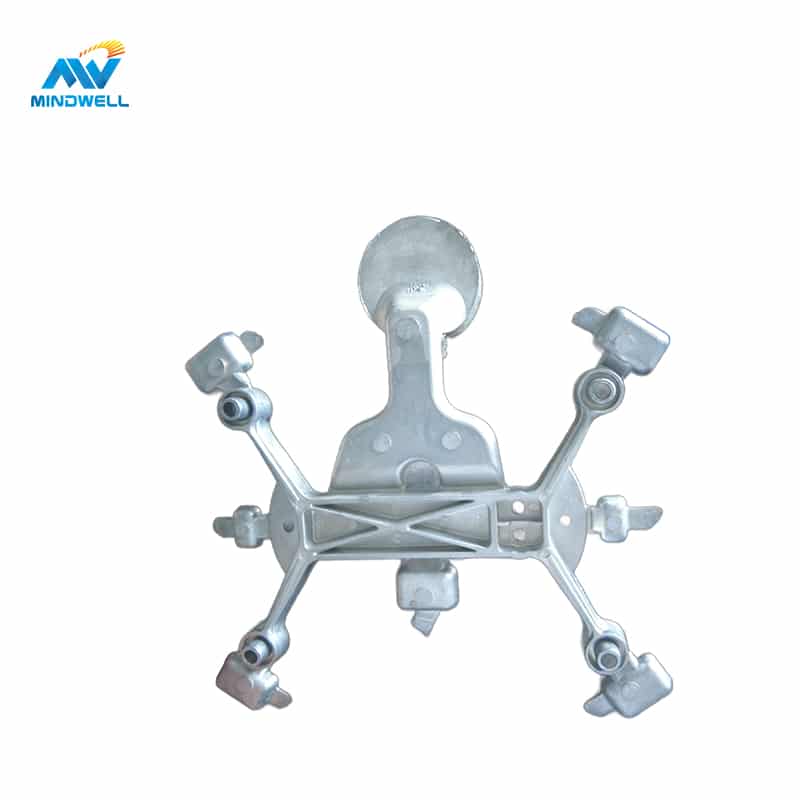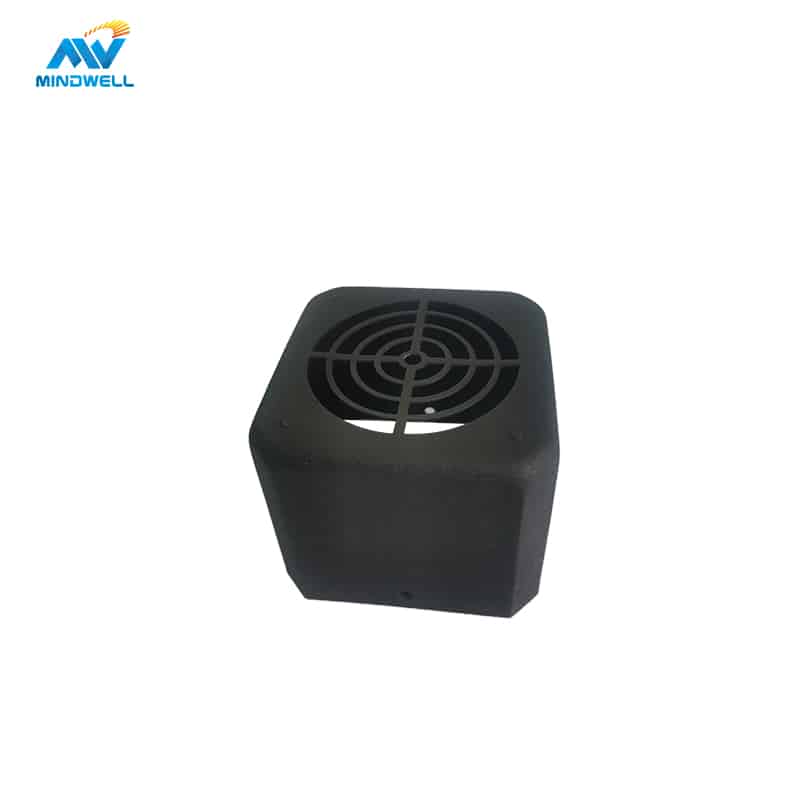Cast aluminum alloy is a cast alloy formed by adding other metal or non-metal elements on the basis of pure aluminum. The cast aluminum alloy not only maintains the basic properties of pure aluminum, but also has good comprehensive properties due to the effect of alloying and heat treatment.
Cast aluminum alloys can be divided into five categories according to the main elements they contain: cast aluminum-silicon alloys, cast aluminum-copper alloys, cast aluminum-magnesium alloys, cast aluminum-zinc alloys, and cast aluminum rare earth alloys. Among them, cast aluminum-silicon alloy and cast aluminum-copper alloy are commonly used.
The expression method of cast aluminum alloy code is different from that of copper-gold alloy. It expresses a certain aluminum alloy with a certain numerical code. For example ZL101, where ZL means cast aluminum. The first number in the three numbers indicates aluminum alloys with different chemical compositions, 1 is aluminum-silicon alloy, 2 is aluminum-copper alloy, 3 is aluminum-magnesium alloy, 4 is aluminum-zinc alloy, and the following two numbers indicate different codes of the same aluminum alloy.

Composition of commonly used cast aluminum alloys
- Aluminum-silicon alloys, also known as “silicon-aluminum” or “silicon-aluminum”. It has good casting performance and wear resistance, and has a small thermal expansion coefficient. It has the most varieties and the largest amount of alloys in cast aluminum alloys. The silicon content is 4% to 13%. Sometimes 0.2% ~ 0.6% magnesium is added to silicon-aluminum alloy, which is widely used in structural parts, such as shells, cylinders, boxes and frames. Sometimes adding an appropriate amount of copper and magnesium can improve the mechanical properties and heat resistance of the alloy. Such alloys are widely used in the manufacture of components such as pistons. the
- Aluminum-copper alloy, the alloy containing 4.5% to 5.3% copper has the best strengthening effect, and the addition of manganese and titanium can significantly improve the room temperature, high temperature strength and casting performance. It is mainly used to make sand castings with large dynamic and static loads and uncomplicated shapes. the
- Aluminum-magnesium alloy, the cast aluminum alloy with the lowest density (2.55g/cm3) and the highest strength (about 355MPa), containing 12% magnesium, has the best strengthening effect. The alloy has good corrosion resistance in the atmosphere and seawater, and has good comprehensive mechanical properties and machinability at room temperature. It can be used as radar bases, aircraft engine casings, propellers, landing gear and other parts, and can also be used as decorative materials. the
- Aluminum-zinc alloys, silicon and magnesium elements are often added to improve performance, often called “zinc-silicon-aluminum”. In the as-cast condition, the alloy has a quenching effect, that is, “self-quenching”. It can be used without heat treatment, and the casting has higher strength after metamorphic heat treatment. After stabilization treatment, the size is stable, and it is often used to make models, templates and equipment supports.
Cast aluminum alloys have the same alloy system as wrought aluminum alloys, and have the same strengthening mechanism as wrought aluminum alloys (except for strain strengthening). Their main difference is that the maximum content of alloying element silicon in cast aluminum alloys exceeds that of most wrought aluminum alloys. In addition to strengthening elements, the cast aluminum alloy must also contain a sufficient amount of eutectic elements (usually silicon) so that the alloy has considerable fluidity and is easy to fill the shrinkage gap of the casting during casting. At present, there are only the following 6 types of basic alloys:
- ① Al-Cu alloy
- ②Al-Cu-Si alloy
- ③ Al-Si alloy
- ④ Al-Mg alloy
- ⑤Al-Zn-Mg alloy
- ⑥ Al-Sn alloy

Defect analysis of aluminum alloy die casting
Oxidation slag
Defect characteristics: Oxidized slag inclusions are mostly distributed on the upper surface of the casting, in the corners of the mold that are not ventilated. The fracture is mostly off-white or yellow, which can be found by X-ray perspective or during mechanical processing, and can also be found during alkali cleaning, pickling or anodizing.
cause:
- Furnace charge is not clean, excessive use of returned charge
- Poor gating system design
- The slag in the alloy liquid is not cleaned
- Improper pouring operation, bringing in slag inclusions
- Not enough standing time after refining and deterioration treatment
Prevention method:
- Furnace charges should be sand blown, and the amount of returned charge should be appropriately reduced
- Improve the gating system design and improve its slag retaining ability
- Use appropriate flux to remove slag
- When pouring, it should be stable and pay attention to slag blocking
- After refining, the alloy liquid should be allowed to stand for a certain period of time before pouring
Stomatal bubbles
Defect characteristics: The pores in the wall of the three castings are generally round or oval, with a smooth surface, usually shiny oxide skin, sometimes oily yellow. Surface pores and bubbles can be found by sandblasting, and internal pores and bubbles can be found through X-ray perspective or mechanical processing, and the pores and bubbles appear black on the X-ray film.
cause:
- Casting alloy is not stable, gas is involved
- Organic impurities (such as coal dust, grass root horse manure, etc.) are mixed into the mold (core) sand
- Poor ventilation of mold and sand core
- Shrinkage cavity on cold iron surface
- Poor gating system design
Prevention method:
- Correctly grasp the pouring speed to avoid getting involved in gas.
- The mold (core) sand shall not be mixed with organic impurities to reduce the gas generation of the molding material
- Improved venting capacity of (core) sand
- Proper selection and handling of cold iron
- Improved gating system design
Shrinkage
Defect characteristics: Shrinkage porosity of aluminum castings generally occurs at the thick and large part of the root of the flying riser near the inner runner, the thickness transition of the wall and the thin wall with a large plane. The fracture is gray in the cast state, and light yellow after heat treatment, it is grayish white, light yellow or gray black, and it is cloudy on the X-ray film. Severe filamentous shrinkage can be found by inspection methods such as X-ray and fluorescence low-magnification fracture. the
cause:
- Riser feeding effect is poor
- Too much gas in the charge
- Overheating near the ingate
- The sand mold has too much moisture, and the sand core has not been dried
- Coarse Alloy Grain
- Improper position of the casting in the mold
- The pouring temperature is too high and the pouring speed is too fast
Prevention method:
- Replenishing molten metal from the riser to improve the design of the riser
- Charge should be clean and free from corrosion
- Riser is set at the shrinkage part of the casting, and chilled iron is placed or used in combination with chilled iron and riser
- Moisture control of molding sand, and sand core drying
- Take measures to refine the grain
- Improve the position of the casting in the mold to reduce the pouring temperature and pouring speed
crack
Defect characteristics:
- Casting cracks. Developing along the grain boundary, often accompanied by segregation, is a kind of crack formed at a higher temperature, which is prone to appear in alloys with larger volume shrinkage and castings with more complex shapes.
- Heat treatment cracks: Transgranular cracks are often caused by heat treatment overburning or overheating. It is often caused by excessive cooling of alloys with large stress and thermal expansion coefficient. Or when there are other metallurgical defects Causes:
- The structure design of the casting is unreasonable, there are sharp corners, and the thickness of the wall varies greatly.
- Sand mold (core) yield poor
- Local overheating of the mold
- Pouring temperature is too high
- Premature removal of casting from mold
- Overheating or overheating in heat treatment, excessive cooling rate
Prevention method:
- Improve the structural design of castings, avoid sharp corners, strive for uniform wall thickness, and smooth transition
- Take measures to increase the yield of the sand mold (core)
- Ensure simultaneous solidification or sequential solidification of all parts of the casting, and improve the design of the gating system
- Appropriately reduce the pouring temperature
- Control mold cooling time
- The thermal correction method is used when the casting is deformed
- Correctly control the heat treatment temperature and reduce the quenching cooling rate
Pore analysis
Among the defects of die castings, the most common ones are pores.
stomatal features. It has a smooth surface and is round or oval in shape. Manifestations can be on the surface of the casting, or subcutaneous pinholes, or inside the casting.
(1) Gas source
1) Alloy liquid precipitation gas—a is related to raw materials b is related to smelting process
2) The gas involved in the die-casting process ¬—a is related to the die-casting process parameters b is related to the mold structure- 3) The release agent decomposes to generate gas ¬—a is related to the characteristics of the coating itself b is related to the spraying process
(2) Analysis of raw materials and gases generated during the smelting process
The gas in molten aluminum is mainly hydrogen, accounting for about 85% of the total gas. the
The higher the smelting temperature, the higher the solubility of hydrogen in molten aluminum, but the solubility in solid aluminum is very low, so during the solidification process, hydrogen is precipitated to form pores. the
Source of Hydrogen:
- 1) Water vapor in the atmosphere, and the molten metal absorbs hydrogen from the humid air. the
- 2) The hydrogen content of the raw material itself, the surface of the alloy ingot is wet, and the returned material is dirty and oily. the
- 3) Tools and flux are wet. the
(3) Analysis of gas generated in the die casting process
Since the pressure chamber, gating system, and cavity are all connected to the atmosphere, and the molten metal is filled at high pressure and high speed, if an orderly and stable flow state cannot be achieved, the molten metal will generate eddy currents and gas will be involved.
The following issues need to be considered in the formulation of die casting process:
- 1) Whether the molten metal can flow cleanly and smoothly in the pouring system without separation and eddy current.
- 2) Are there sharp corners or dead zones?
- 3) Is there any change in the cross-sectional area of the gating system?
- 4) Is the position of exhaust groove and overflow groove correct? Is it big enough? Will it be blocked? Can the gas be discharged effectively and smoothly?
The application of computer to simulate the filling process is to analyze the above phenomena and make judgments to select reasonable process parameters.
(4) Gas analysis of coatings
Coating properties: If the gas generation is large, it will directly affect the porosity of the casting.
Spraying process: Excessive use, resulting in a large amount of gas volatilization, too much punch lubricant, or burnt, are all sources of gas.
(5) Ways to solve the porosity of die castings
First analyze what causes the pores, and then take corresponding measures.
1) Dry and clean alloy material.
2) Control the melting temperature, avoid overheating, and perform degassing treatment.
3) Reasonable selection of die-casting process parameters, especially injection speed. Adjust the starting point of high-speed switching.
4) Sequential filling is conducive to the discharge of gas from the cavity, and the sprue and runner have sufficient length (>50mm) to facilitate the smooth flow of the alloy liquid and the opportunity for gas to be discharged. The gate thickness and gate direction can be changed, and overflow grooves and exhaust grooves can be set at the positions where pores are formed. The sum of the cross-sectional areas of the overflow products should not be less than 60% of the sum of the cross-sectional areas of the ingates, otherwise the slagging effect will be poor.
5) Select paint with good performance and control the amount of spraying.
Solutions
Equipment adjustment
Since the cause of each defect comes from many different influencing factors, in order to solve the problem in actual production, in the face of many reasons, is it right to adjust the machine first? Or refuel first? Or modify the mold first? It is recommended to deal with it according to the degree of difficulty, first simple and then complex, in order:
- 1) Clean the parting surface, clean the cavity, and clean the ejector pin; improve the coating and spraying process; increase the clamping force and increase the amount of pouring metal. These measures can be implemented with simple operations. 2) Adjust process parameters, injection force, injection speed, filling time, mold opening time, pouring temperature, mold temperature, etc. the
- 3) Refueling, select high-quality aluminum alloy ingots, change the ratio of new materials to recycled materials, and improve the melting process. the
- 4) Modify the mold, modify the gating system, increase the inner gate, add overflow grooves, exhaust grooves, etc. For example, the causes of flashing in die castings are:
1) Die casting machine problem: The clamping force is not adjusted correctly. the
2) Process problem: the injection speed is too high, and the pressure shock peak is too high. the
3) Mold problems: deformation, debris on the parting surface, wear and tear on inserts and sliders, and insufficient strength of the template. The order of measures to solve the flash: clean the parting surface → increase the clamping force → adjust the process parameters → repair the worn parts of the mold → increase the rigidity of the mold. From easy to difficult, every step of improvement should be tested first, and if it fails, proceed to the second step. the
cast aluminum alloy raw material additives
Adding rare earths to cast aluminum alloys can effectively improve the defects of cast aluminum alloys. the
- The refining effect of rare earth in aluminum alloy
Adding an appropriate amount of rare earth elements to aluminum alloy can promote the refining effect. Rare earth elements can improve the shape of inclusions and purify grain boundaries. Vacuum suction casting method was used to study the influence of Al RE master alloy on the fluidity of A356 alloy. The experimental results proved that adding an appropriate amount of rare earth elements to the alloy melt can reduce the temperature difference between solid and liquid phase lines, reduce the paste solidification tendency of the alloy, and reduce the surface tension of the alloy melt. In addition, it also has the refining effect of degassing and impurity removal, which will improve the fluidity of the melt and reduce the viscosity, which is conducive to the removal of inclusions and gases. A new aluminum alloy flux containing rare earth compounds has been researched and developed. Through a series of physical and chemical reactions, the flux can not only reduce the hydrogen content of A356 alloy melt from more than 0.30ml/100g(Al) to below 0.10ml/100g(Al) at 720℃, and has a significant degassing effect, but also increases the room temperature tensile strength of A356 alloy by 7.27%, and the elongation rate increases by 85.58%. However, excessive rare earth elements will also aggravate the aggregation of RE-rich phases and become inclusions, thereby reducing the fluidity of the alloy melt. the
- The refinement effect of rare earth on aluminum alloy
Purposefully suppress the growth of columnar crystals and double columnar crystals, and promote the formation of fine equiaxed crystals. This process is called grain refinement. Due to the refinement of grains, the performance of the alloy is improved, and at the same time, defects such as shrinkage porosity, thermal cracking, and pinholes are reduced. The most basic method of refinement is to suppress nucleation, and to add foreign nucleation particles of grain refiner to the melt. At present, the method of adding a refiner has become the most effective and practical method. There are three types of grain refiners commonly used in cast aluminum alloys: binary Al-Ti alloys, binary Al-B alloys and ternary Al-Ti-B alloys. The master alloy (grain refiner) is added to the aluminum alloy melt to dissolve, release the intermetallic compound phase, and become the foreign nucleation core. the
Adding rare earths to aluminum alloys can not only refine the grains, but also significantly refine the dendrite structure (reduce the secondary dendrite spacing), and the best effect corresponds to different rare earth contents. However, its refining effect is weaker than that of Ti, B and other elements. The critical value of rare earth addition is closely related to the melting and casting conditions of the alloy. Only under certain production process conditions, a certain amount of rare earth will have the best refining effect. With the use of general refiners, the refinement effect gradually declines with the prolongation of the standing time of the aluminum liquid; with the use of Al-5Ti-1B-10RE master alloy, the rare earth elements can prevent the aggregation and precipitation of refinement elements, and have a certain promotion effect on the refinement of Ti and B, which can effectively inhibit the decline of the grain size of the aluminum-silicon alloy during the long-term standing process, and is suitable for mass production of automotive aluminum alloy castings.






